-

Visually categorising a selection of my research material (accumulated since 2015).
-
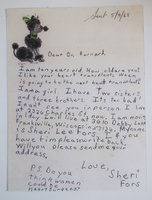
Dear Dr Barnard,
I am ten years old. How old are you? I like your heart transplants. When is going to be the next heart transplant? I am a girl. I have two sisters and three brothers. Its too bad I can't see you in person. I live at 2326 Charles St. now. I am moving in 1 day. I will live at 3610 Denny Lane, Franksville, Wisconsin. My name is Sheri Lee Fors. If you have time please write back. Will you please send me your address.
Love, Sheri Fors.
P.S. Do you think women could be heartsurgens?
-
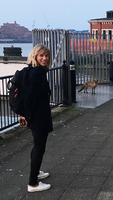
The researcher who conducted this study and wrote the dissertation, 'The Virus and the Vaccine: Curatorship and the Disciplinary Outsider '(2021).
-
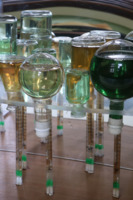
"The bottles and pipettes in 'Forest' were originally sourced from the storage rooms of the Chemistry department, where they awaited disposal. This cabinet responded to the lacuna of indigenous material represented by the chest and addressed this imbalance by filling the bottles with teas made from local medicinal plants. Staging the bottles and pipettes to simulate a forest references the prejudice of Burroughs, Wellcome and Co (BWC) against these natural remedies, ‘purifying’ them through laboratory processes before they were deemed trustworthy and marketable. This process also occluded the original source of the remedies and sowed the seeds of biopiracy. The various items of glassware in this cabinet were filled with a selection of infusions made from Balotta africana, Sutherlandia frutescens, Agathosma crenulata, Melianthus major, Mentha longifolia, Petroselinum crispum, Hypoxiz villosa and Salvia officinalis" (Liebenberg 2021: 255).
-
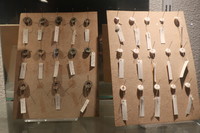
A display of a collection of pins, buckles and buttons excavated from the washing pools used by slaves on Table Mountain. Taken from their dusty boxes in storage they are currently exhibited as part of Skotnes's 'Division of the World' (Department of Archaeology).
-
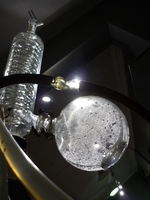
An experiment in three parts, reversing the first miracle.
-
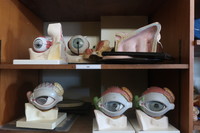
Educational models found in the Anatomy workshop:
"Borrowing from Herbert Read’s art historical discussion on looking, Digby posits that the biomedical practitioner’s generally critical attitudes were shaped in part by their limited recognition of indigenous medicine during this period – ‘what we see is inseparable from how we see; the eye is not innocent, and vision is partial’ (Digby 2006: 356) and, quoting Read, ‘we see what we learn to see, and vision becomes a habit, a convention, a partial selection of all there is to see’ (in Digby 2006: 356). Accordingly, Digby argues that the Western practitioners would have had, at best, only a partial view of the different medical systems in South Africa during this period (Digby 2006: 357) and probably only to the extent that it was a threat to their own livelihood and authority – as evidenced in the 1928 Medical, Dental and Pharmacy Act that Floyd helped instate" (Liebenberg 2021: 55).
-

The expedition carried with them a Tabloid Medicine Chest. On the 11th of March, knowing that the party was unlikely to survive, Scott ordered Edward Wilson, the expedition’s Chief Scientist and a qualified doctor, to divide the painkillers between them so they could each end their life on their own terms. Writing in his diary on that day, Scott states, “I practically ordered Wilson to hand over the means of ending our troubles to us, so that anyone of us may know how to do so".
Scott, Bowers and Oates had thirty opium tabloids apiece and Wilson, the morphine. Scotts diary entry on either the 22nd or 23rd of March showed that they had a change of heart however: “no fuel and only one or two left of food — must be near the end. Have decided that it shall be natural — we shall march for the depot with or without our effects and die in our tracks".
-
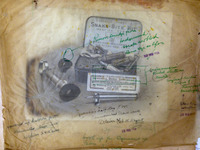
Examples of Wellcome's design changes annotated on tracing paper. 1914–1938. WF/M/I/PR/O01/3, 4, 9, 8. Wellcome Collection.
-
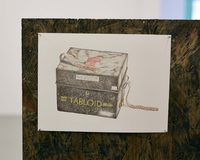
A drawing by the artist-curator James Hutchinson (Chapter Thirteen) based on an audio description of the object as art of the Glasgow International Arts festival.
"Nina Liebenberg also undertakes a form of object analysis at an institutional border. She spent an afternoon in the strongroom of the University of Cape Town's special collections department, examining an early 20th century medicine box commissioned for a hunting trip in (then) Northern Rhodesia. Such boxes had been essential parts of the British colonial project, and allowed emigres, missionaries and explorers to venture deeper into unknown territory without fear of contracting tropical diseases. Liebenberg’s report from the strongroom acts as a set of instructions for The Landis Museum’s curator to make a drawing of the box, to which he has no physical access".
Extract from the 'Exhibition Guide' of the Landis Museum (Chapter Thirteen), Glasgow International Arts Festival, 20 April - 07 May 2018.
-

Georgian silver spoon drawn to the height of Niagara Falls.
-
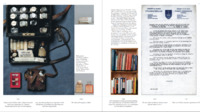
"The caption for the image offered further information about the department in which the medicine chest was located, stating: ‘Black metal travelling medicine chest, containing bottles and packets of medication belonging to Walter Floyd, given to UCT by the Floyd family (Manuscripts and Archives).’
It seemed strange to me that this three-dimensional object would be housed in the Manuscripts and Archives (M&A) department (also known as ‘Special Collections’) of UCT Library, as it hosts collections of ‘printed and audio-visual materials on African studies and a wide array of other specialised subjects, as well as over 1,300 sub-collections of unique manuscripts and personal papers’ (Special Collections 2015). As my italics emphasise, bulkier three-dimensional objects seemed to have no place here.
I nonetheless thought it worthwhile to type the words ‘medicine chest’ into the general library search engine, an application called Ex Libris Primo; the search delivered no results" (Liebenberg 2021: 24).
-

Hiddingh Hall during the construction of the installation of Curiosity CLXXV.
-

"Along with the guides that regulated practices and protocols to stabilise and standardise an individual’s response to unfamiliar and disorienting sights (Kennedy 2013: 42), the gender, class and ethnicity of the observer were also of importance , as was the use of ‘ever more sophisticated instruments and calculations designed to minimize the intrusion of subjectivity into the reporting of information’ (Driver 2001: 55). By regulating who was doing the viewing, stipulating what should be viewed and how and supplying tools to measure these observations, scientific institutions promoted an authoritative ‘way of seeing’ in the field that differentiated the scientific view from that of the ordinary traveller (Driver 2001: 49)" (Liebenberg 2021: 109).
-
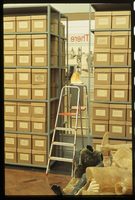
An extract from an email from archaeologist and former head of African Studies, Prof Nick Shepherd (Jan 21, 2021, 11:33 AM):
"Disciplinary practices and regimes of care constitute a kind of bureaucratization or governmentality of elapsed time and its material remains and human relationships, placing these remains and relationships under a kind of administration. We think of the elaborate structure of regional typologies and chronologies, the immense work of correctly assigning artefacts and sites to these imagined categories, and the vast institutional apparatus that supports these endeavors – all of which constitute archaeology as a formidable disciplinary enterprise. In the face of this enterprise, the 'many worlds' of local claims to the past have little chance of success."
-
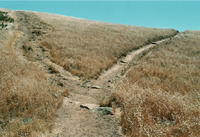
"The processes of digression and diversion have much in common with what the writer Ross Chambers (1999) calls ‘loiterature’. Chambers investigates the digressive, category-blurring genre of writing found in works such as Nicholson Baker’s 'The mezzanine', Paul Auster’s 'City of glass' and Laurence Sterne’s 'Tristam Shandy'. Loiterly writing, according to Chambers, disarms criticism by providing a moving target, shifting as its own divided attention constantly shifts.
Criticism depends on the opportunity to discriminate and hierarchise, determining what is central and what is peripheral (Chambers 1999: 9), which this form eludes by resisting contextualisation or singular categorisation. Loiterature promotes sites of endless intersection, where attention is always divided between one thing and some other thing, always willing and able to be distracted, contrasting ‘the disciplined and the orderly, the hierarchical and the stable, the methodical and the systematic’ (Chambers 1999: 10).
In contrast to methods of science that seek to stabilise objects within taxonomic systems or that require the formulation of hypotheses to provide direction for experimentation and a basis for concrete outcomes, the processes of curatorship and artmaking revel in rerouting and redirecting and in diversion and digression" (Liebenberg 2021: 286).
-

The wall text accompanying these charts in the Hunterian museum, Glasgow, reads: "In the late 19th and 20th centuries, before the advent of colour slides that could be projected, the teaching of Zoology depended heavily on the use of wall charts to illustrate lectures. They were hung on a special pulley system at the front of the lecture theatre and, because of their large size, could be clearly seen from the back of the class".
-

Cyanotype on paper. Ink on perspex.
The work shows the exact positioning of the stars from J.M. Barrie’s window at 3 Adelphi Terrace, London (51°30'N 0°7'21"W), on Saturday, 19 June 1937 – the night of his death. Based on the direction of his window, I was able to locate the ‘second star to the right’ at the 45 degree angle he would have stood and viewed the night sky. Hopefully, he reached his destination, after departing the flat and traveling ‘straight on till morning’.
-

Marine biologists studying whalesharks use the pattern-recognition technique, developed in 1986, that astronomers use to analyze data from the Hubble Space Telescope. Studying the spatial relationships between a whaleshark's spots form the basis for creating a unique identifier for each shark.
-

Published in 1841, Jackson’s guide was the first of a series of guides published during this period which offered notes for the traveller on appropriate conduct in the field – from providing methods for training the eye to observe what was deemed as relevant details, to instructions on which precision instruments should be carried and how to use them to record and inscribe the results of observations made (Withers 2013: 170). As Jackson states, his guide pointed out to the “uninitiated Traveller what he [sic] should observe, and to remind the one who is well informed, of many objects which (…) might escape him” (Jackson 1841: i).
-

In 2015, Conservation International scientists in Indonesia attached satellite transmitters to the dorsal fins of whale sharks to learn more about their migratory movements and diving behavior. Dipsy, a 4.57-meter male, spent much of his 17-month deployment in Triton Bay but also visited the Aru and Kei Islands – one of our first Kaimana whale sharks to explore the Arafura Sea – before returning to Kaimana. He hit a maximum depth of 625 meters.
-

In 2015, Conservation International scientists in Indonesia attached satellite transmitters to the dorsal fins of whale sharks to learn more about their migratory movements and diving behavior. Yoda had a lengthy 26-month deployment, spending all of that time in Cendrawasih Bay. The 4.83-meter male dove to a maximum depth of 1,375 meters, reaching the bottom of the bay at one of its deepest points.
-

In 2015, Conservation International scientists in Indonesia attached satellite transmitters to the dorsal fins of whale sharks to learn more about their migratory movements and diving behavior. At just 3 meters in length (about 10 feet), Fijubeca logged an impressive 9,000 kilometers (5,592 miles) during his deployment. He visited eight of the Bird’s Head Seascape's marine protected areas (MPAs), reaffirming the placement of MPAs as related to megafauna migratory routes.
-

In 2015, Conservation International scientists in Indonesia attached satellite transmitters to the dorsal fins of whale sharks to learn more about their migratory movements and diving behavior. Sunbridge was one of our first sharks tagged in Saleh Bay, Sumbawa, where he spent his entire 14-month deployment. Though this 6.23-meter male spent a fair bit of time on the surface, he frequently visited the bay's bottom at a maximum depth of 350 meters.
-

In 2015, Conservation International scientists in Indonesia attached satellite transmitters to the dorsal fins of whale sharks to learn more about their migratory movements and diving behavior. Sebastian spent most of his 27-month deployment in Cendrawasih Bay but also recorded a visit to the Mapia atoll and ventured past Biak into PNG coastal waters. He eventually returned to Cendrawasih, where his tag's battery expired, having logged a maximum dive of 1,125 meters.
-

The Brazilian artist Lygia Clark (1920-1988) produced relational objects to be inhabited and activated by groups of people. Her net made up of elastic bands attached to each other, allows a complex structure, a complex grid, inviting a choreographed dance between strangers as they play with it by pushing and pulling these bands.
-

"Early Pacific seafarers did not have scientific instruments or conventional European-style maps to voyage to, and settle, the thousands of islands of Micronesia and Polynesia. Instead they used the movement of the sea, the direction of the wind, the position of the sun and stars, and the flight of birds. This is a navigation chart, obtained by Georg Irmer, the Governor of the Marshall Islands from Chief Nalu of Jaluit atoll in 1896. The strips of wood, bound by cane, represent the currents and winds, and the six small, white shells represent islands".
-

Captain Scott writes in his den in the Terra Nova hut in this October 7, 1911.
-

"The Hunting of the Snark offers a timely caution for geographical investigation. The danger, both academic and pragmatic, of enslavement to static conceptual categories, rigid classifications, and established methodological procedures is simply that they tend to rule out the possibility of experiencing that insight and understanding which can be neither discovered, formulated nor communicated by adherence to traditional investigative methdologies. This is not to advocate an un-methodical and irrational geographical philosophy, but rather to suggest that there may be conditions under which slavish adherence to a tried and tested methodology may fail to provide reliable guidance in our search for understanding. A lack of commitment to open-ended investigation could mean that, because our methods are inappropriate, our explorations will forever remain, so to speak, 'snarked' ".
-

"He had bought a large map representing the sea, Without the least vestige of land: And the crew were much pleased when they found it to be A map they could all understand".
-

Marseille, France: A resident of a block of flats is passed food by his neighbours using a rope made of blankets.
-

Installation. Material provided by family and friends.
As of 08/18/2009, Moor is 326.9 feet long (99.63 meters). Moor will continue to grow.
-

Installation. Material provided by family and friends.
As of 08/18/2009, Moor is 326.9 feet long (99.63 meters). Moor will continue to grow.
-

Addressing the fact that 95% of known animal species are smaller than our thumbs, yet natural history museums displays are filled with mostly large animals, this sub-museum shows the legs of a flea highlighting its muscles; a whole squid, just a couple of millimetres long; beetles that have been sliced along their entire length, through the antennae, head, legs and body — 1/10th of a millimetre thick; as well as these two baby flounder fish.
-

"With a crowd of pilot fish he prowled around the raft, and went on doing this for so long that that we plucked up courage. And when he lay to under the steering oar to scratch his back a bit, we thumped him in return, in a friendly way rather than otherwise, to see how he took it. But he liked it and came back and let himself be thumped three of four times. Then we gave him a bit of a jab with a harpoon, but we ought to not have done that, for he didn't like it and cleared off" (Hesselberg 1950: 48).
-

Whale sharks (Rhincodon typus) are the largest shark, and indeed largest of any fishes alive today. These gentle marine giants roam the oceans around the globe, generally alone. They only feed on plankton. In the Norwegian explorer, Thor Theyerdal's account of his journey by raft across the Pacific Ocean from South America to the Polynesian islands in 1947, the crew is visited by one of these curious and benign creatures:
"In reality the whale shark went on encircling us for barely an hour, but to us the visit seemed to last a whole day. At last it became too exciting for Erik, who was standing at a corner of the raft with an eight-foot hand harpoon, and, encouraged by ill-considered shouts, he raised the harpoon above his head. As the whale shark came gliding slowly toward him and its broad head moved right under the corner of the raft, Erik thrust the harpoon with all his giant strength down between his legs and deep into the whale shark’s gristly head. It was a second or two before the giant understood properly what was happening. Then in a flash the placid half-wit was transformed into a mountain of steel muscles. We heard a swishing noise as the harpoon line rushed over the edge of the raft and saw a cascade of water as the giant stood on its head and plunged down into the depths. The three men who were standing nearest were flung about the place, head over heels, and two of them were flayed and burned by the line as it rushed through the air. The thick line, strong enough to hold a boat, was caught up on the side of the raft but snapped at once like a piece of twine, and a few seconds later a broken-off harpoon shaft came up to the surface two hundred yards away" .
-

After initially making good progress, Terra Nova expedition party’s prospects steadily worsened as they struggled northward. Deteriorating weather, frostbite, snow blindness, hunger and exhaustion led to Edgar Evans dying on 17 February and Lawrence Oates, whose condition was aggravated by an old war-wound to the extent that he was barely able to walk, voluntarily leaving his tent on 16 March and walking to his death. (“I am just going outside and may be some time".)" (Liebenberg 2011: 75).
-
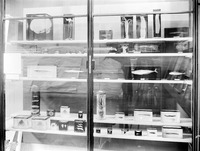
Robert Falcon Scott’s Terra Nova expedition reached the South Pole on 17 January 1912 — 23 days too late. Inside a small tent supported by a single bamboo flying a Norwegian flag, was a record of the five who had been the first to reach the pole: Roald Amundsen, the leader, and his team - Olav Olavson Bjaaland, Hilmer Hanssen, Sverre H. Hassel and Oscar Wisting.
On 19 January, they began their 1,300 kilometre journey home, Scott writing: “I’m afraid the return journey is going to be dreadfully tiring and monotonous” (Scott 1914: 548).
-

A showcase of fish found in the Artic regions.
-
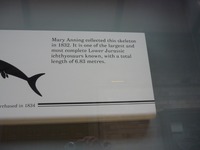
A label in the Natural History Museum accompanying a discovery made by Mary Anning.
-

"Our hands resemble fossil fins; our heads are organised like those of long extinct jawless fish and major parts of our genomes still look and function like those worms and bacteria" (Shubin 2008).
During the summer of his second year of study, paleontologist and evolutionary biologist, Neil Shubin, discovered a particular fossil fish in the Arctic, naming it the Tiktaalik. In Your Inner Fish: A Journey into the 3.5-Billion-Year History of the Human Body (2009) he explored the connections in our human anatomy with those fishes that ventured onto land over 375 million years ago, based on the information gathered from studying the Tiktaalik.
-

The evolution of jaw muscles from fish to men.
-

A label accompanying Robert Louis Stevenson's fishing gear.
-

"Dear Doctor Barnard
I am an 11 year old girl, and I have a problem: I went fishing today; when we came back, my parents cleaned the fish, and after they took out the insides, they found a heart of a fish beating, but the fish was dead and cut up. It was still beating for about 1/2 an hour. Can you explain that? I am very interested in biology, and so is everyone else in my family.
Sincerely Yours,
Lillian Levy
P.S. I know you are a very busy man, but, if you have enough time, please try to answer. THANK YOU!
P.P.S. If a doctor says you're dead and they take out your heart but it is still beating, are you dead or alive?"
Transcribed letter from the Heart of Cape Town Museum
-

Fishing rods over a bridge in Istanbul.
-

"The BWC shop was located a short walk from Walter Floyd’s dental practice which he bought in 1904 (for £2,404 16s 8d) and shared with his partner, William Johnston. It is uncertain when Floyd first came out to South Africa, but records prove that he was living here by January 1902 (Hart & Lydall, 1981: 1)" (Liebenberg 2021: 52).
In interviews with Mary Floyd in 2015, I showed her this photo of her father-in-law on the boat, en route to Cape Town, and asked her whether she knew who the woman in the photo was. (She appeared in quite a few photos of Floyd's from this period – one especially intimate one showing her lying on a beach and smiling coyly at the photographer.) Was it Agnes, perhaps? She said it definitely wasn't.
-

"When it (the chest) is not being exhibited in the Iziko South African Museum, it lives in the archives of the University of Cape Town. As part of an institution that has sworn dedication to decolonising its curriculum, it poses a somewhat latent threat. In a speech in 2015, the writer and previous vice-chancellor of the University of Cape Town, Professor Njabulo Ndebele, stated "that there can be no transformation of the curriculum, or indeed of knowledge itself, without an interrogation of archive". It is an argument which strongly suggests that a critical assessment of the archival legacy on which the institution is founded becomes of pivotal importance when developing a decolonial institution.
What worth then, if any, does this dormant object serve in a new curriculum?"
Extract from a paper delivered at the BSHS conference in Cambridge, 2019
-

"All that debris still remains under the bridge for the most part, and it has become a dive site. It is a very difficult dive site to get to because of the swiftly moving water and the very short period of slack time.
Nature in this area has just a tremendous ability to take over. You have a man-made structure like the Tacoma Narrow Bridge that collapsed into the water. Very quickly, the ocean took it over and made it part of the habitat".
Extract from the voiceover of trailer for 700 Feet Down (a documentary about the Tacoma Narrows Bridge told through witnesses of the bridge’s 1940 demise as well as intrepid divers exploring a reef of wreckage, ultimately reflecting on how history influences the present)
-

"As I stood there, suddenly, no, not suddenly, but in a sort of driving heave, the whole sea surged, it was not a wave, but a smooth rolling swell that seemed to come up from the deeps, as if something vast down there had stirred itself, and I was lifted briefly and carried a little way toward toward the shore and then set down on my feet as before, as if nothing had happened. And indeed nothing had happened, a momentous nothing, just another of the great world's shrugs of indifferennce (Banville 2005: 26)
-

A year after Simone's death from cancer, Cousteau announced that he had been having an affair with a woman, Francine Triplet, for over a decade. He also had two children with her, Diane and Pierre-Yves.




















































